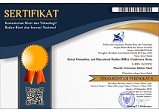Improvement of Health Interference Science Learning Result on Blood Circular Organs Through The Learning Video in Class V Students
Abstract
The background of this research problem is that teachers have not been able to maximize the use of media, especially learning media. This raises various problems for students such as students who are less interested in paying attention to the explanations given by the teacher, students look bored, and in the end students are less active in participating in the teaching and learning process in class and the science learning outcomes of grade V students of SDN Kedalon 01 are low. This study aims to improve student science learning outcomes and describe the use of instructional media in accordance with learning objectives. This type of classroom action research consists of 2 cycles, each cycle consisting of 1 meeting. The research subjects of the fifth grade students of SD N Kedalon 01 were 21 students. The data collection instrument used tests and non-tests. The research instrument was in the form of multiple choice test questions, observation sheets and observations. The results showed an increase in student learning outcomes. The increase in student learning outcomes seen from the classical average value, in cycle I was 76.19%, and cycle II increased to 86%, and cycle III increased to 90%. So the instructional video media can improve students' mathematics learning outcomes. Teachers can apply instructional video media to improve science learning outcomes. Teachers must be able to apply learning models and media that can increase interest and motivation of students in learning
Keywords
Learning Media, Science and Science Learning Outcomes
Full Text:
PDFRefbacks
- There are currently no refbacks.





